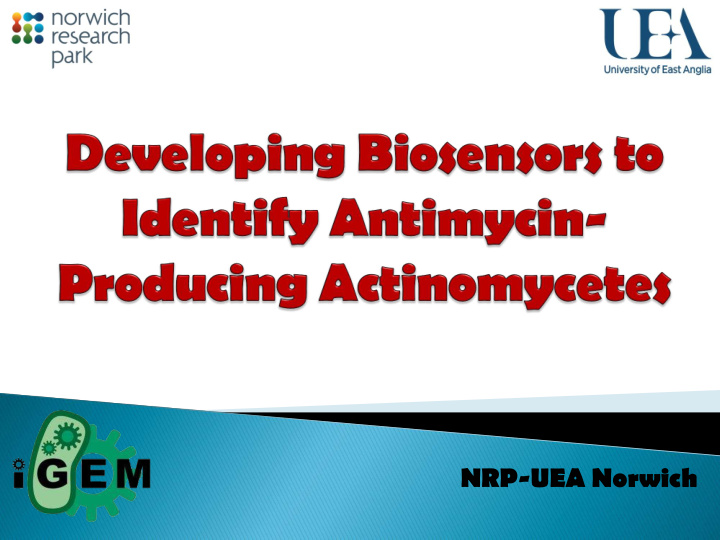



NRP-UEA Norwich
Lucy Clark Matt Batchelor Biochemistry Molecular Biology and Genetics 3 rd Year 3 rd Year Becky Spanner Biological Sciences with a year in Industry 3 rd Year Beth Williams Biological Sciences 3 rd Year Divya Thankachan Microbiology 3 rd Year Michael Brown Natural Sciences 1 st Year Shaima’a Hamarsheh Molecular Biology and Genetics 3 rd Year
Antibiotic resistance is a massive problem The search for new antibiotics is more important than ever We focused on finding novel antimycins from soil bacteria Despite certain challenges, we produced various biosensors to screen soil for this group of antibiotics.
Resistance to antibiotics is growing at an alarmingly fast rate. If solutions are not found, routine operations and simple diseases could soon become deadly.
Antibiotics, used as piscicides, insecticides and fungicides. NEMATOCIDES!? Tailoring enzymes Anti-cancer properties
It is the most highly expressed of the AntA regulator genes antGp is the specific target of the sigma factor AntA.
neo should confer kanamycin resistance to AntA- producing bacteria. Test by function, not sequence. More cost effective and efficient.
Identify actinomycetes using an AntA target promoter ( antGp ) to control three reporters: ◦ neomycin resistance gene ◦ RFP (red fluorescent protein) ◦ GUS (providing β -glucoronidase activity) Produced and trialled where possible. GUS selectivity: using the blue halo Used soil samples to produce a library of actinomycete strains, to test the biosensors.
Three new biobricks; The laboratory on one, an improved floor two focused on biobrick from the cloning and registry, one containing characterising the the biosensor neo, and team’s biobricks. one, RFP.
The 3 biobricks made and characterised on Floor 2. We also designed two other biobricks that are yet to be characterized.
AntA is only produced briefly during the lifecycle of actinomycetes. AntA Adapted the project: Expressed ◦ decided to use non-lethal selection reporters like RFP and GUS ◦ as well as trying to optimise the neo-construct.
Large number and variety of soil samples Observe the distribution of bacteria Opportunity to test out reporter on unknown bacteria
E.coli and other soft bugs replicate using binary fission:
Creamy substance Used to test the antifungal – C.albicans properties of a bacteria Challenge the colony using a Candida albicans overlay Any zone of clearing around the colony suggests the presence of an antifungal. 16S sequence successes.
300+ Spore Stocks in our strain library! Bioassays demonstrating antifungal properties 16S results showing Streptomyces sp. ..HOMO SAPIEN DNA!?
100 Flasks 50 litres of SFM Media 2000+ Plates!
POTENTIAL ANTIMYCIN Laboratory PRODUCERS Analysis ˃ Against C.albicans Unique Natural Sequencing ˃ Extract Antimycin Antimycins ˃ HPLC against known standards Clinical Trials Variable Clusters ˃ LC-MS on isolated ˃ New Tailoring Enzymes compound ˃ Novel Antimycin? LABS HEALTHCARE STRAIN LIBRARY Engineer synthetic antimycins/antibiotics CONSTRUCTS
Invaluable experience in a laboratory Brand new set of skills Taste of ‘real’ research: ◦ Starting something unknown ◦ Overcoming challenges ◦ Adapting the project to the needs at the time
Community building in the city centre We had a stall with literature, posters and hands-on activities for all ages.
UEA’s 50 th Anniversary Festival Making science and research accessible to the general public Spoke to a range of people, from children to alumni
Eastern Daily Press (EDP) article and press release Society of General Microbiology Podcast Mentions on BBC Radio 4 and BBC Radio Norfolk Social Media Outreach
Talk to local secondary school students at UEA. Students as Partners Summit at the Higher Education Academy Summer Student Afternoon at UEA Young Synthetic Biology Conference at Wellcome Trust and UCL.
Our Initiatives: Soil Collections from around the world! The Outreach Resource Library Other Initiatives: Bricks of Knowledge Video ◦ Copenhagen iGEM Standard Protocol for iGEM Registry ◦ Purdue iGEM
To UEA for the use of To everyone who sent their labs and the us soil and was so provision of funding helpful to us! and expertise To all of these companies for support, funding and for making our project possible
And an extra special thanks to: ◦ Matthew Hutchings ◦ Richard Bowater ◦ Kay Yeoman ◦ Ryan Seipke ◦ John Munnoch ◦ Ben Pinchbeck For all their help and advice throughout this project…it couldn’t have happened without them!
Recommend
More recommend